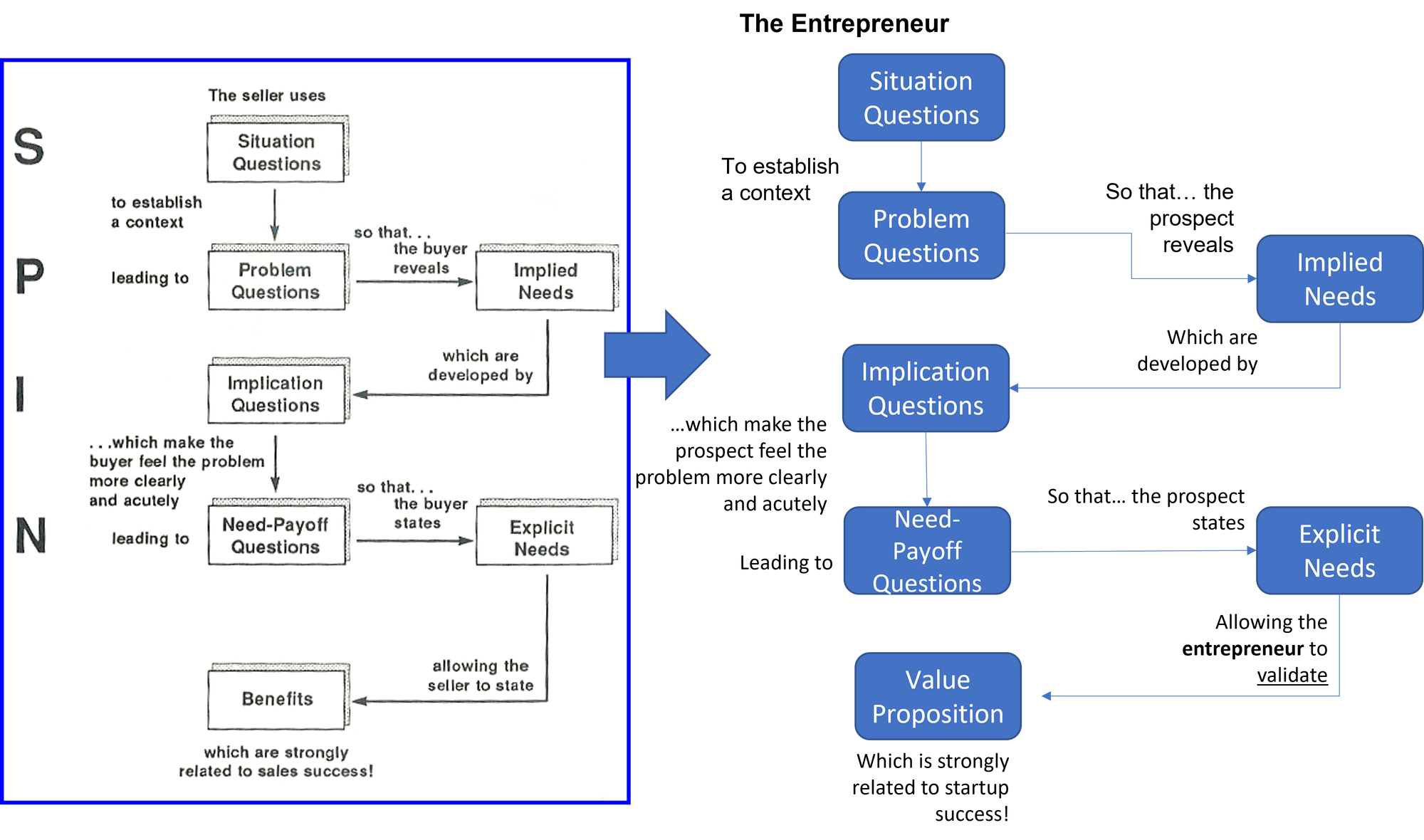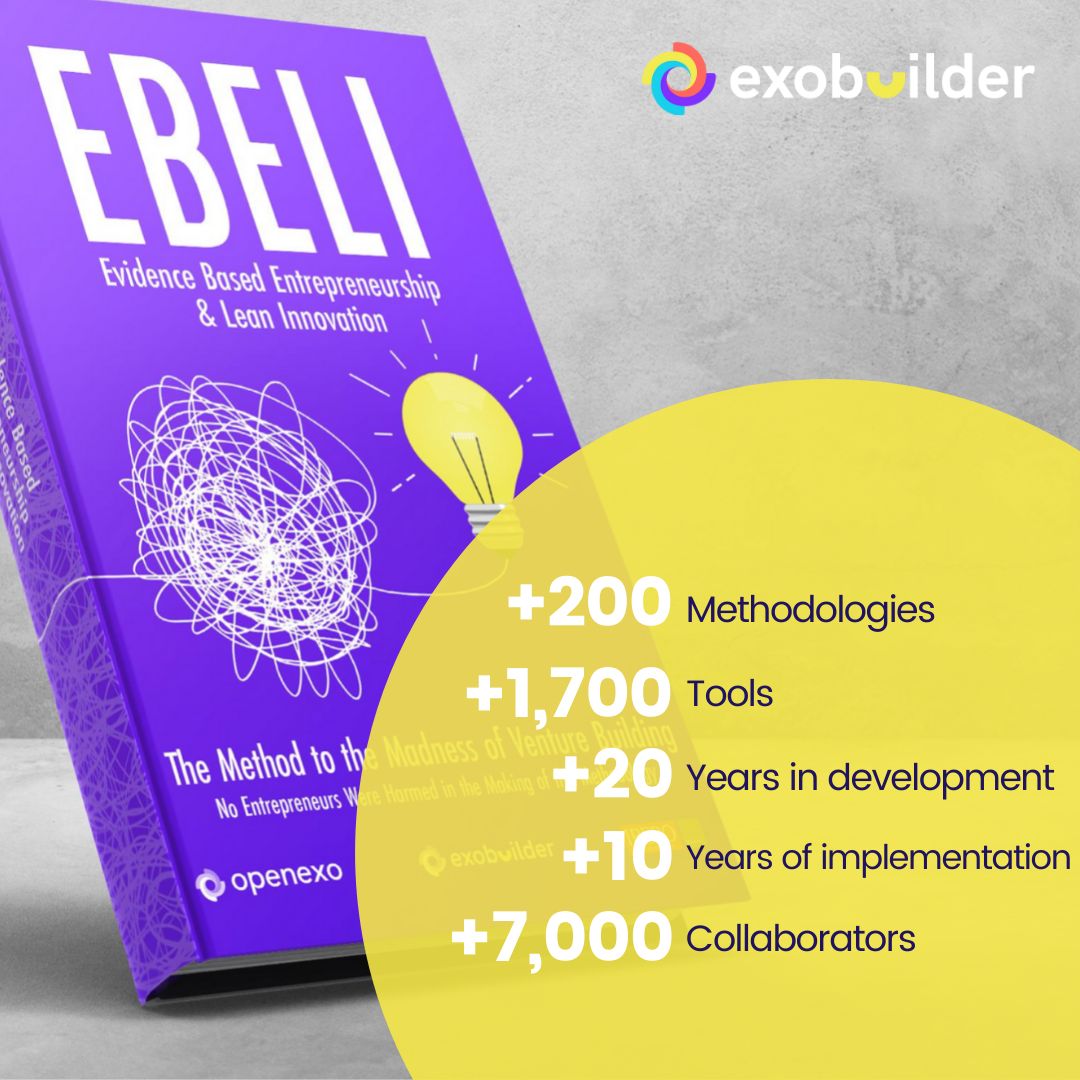
Want Your Startup to Succeed...Faster?
This technique helps organize sales calls using questions to understand Customer Situations, their Problems, the Implication of their problems, and the Need-payoff.
Most startups and businesses overestimated the speed of finding customers. Yet, having them is the lifeblood they need to survive and thrive.
Get out of the Building!
In the past, startup businesses focused on sales before anything else; business owners were also salesmen and learned to manage their business. In today's world, we have learned there is a better way to succeed with your Startup using innovative methodologies like EBELI (Evidence Based Entrepreneurship and Lean Innovation). EBELI is a 7-step process for venture building, and before you invest a ton of money, you can learn from the market to build a product or service that reaches market fit.
Every successful Startup focuses on solving a problem with a product or service that they can build and how they will deliver the solution to a customer with a convincing value proposition. To understand if the value proposition is strong enough to create the customer, entrepreneurs must get out of the building in front of prospects and talk about their idea and if their solution is attractive to them.
The best way to do this is through research. There are two types of research, primary and secondary. Primary research is "get out of the building, not to the parking lot, but in front of customers," as Steve Blanc said to Inc. Magazine in 2014. This process is where you or your team talk directly with prospects or potential customers. First, you ask them what they need, want, like, or dislike. Next, you try to understand if there is a market fit for your solution and if your customers are willing to pay for it. In my experience as an Instructor and sherpa (coach) of the EBELI methodology, this process is where entrepreneurs get their hands-on business model validation through market surveys or focus groups.
Secondary research is getting information from other sources that have done the previous study. You can buy them or get them for free, but you have not validated your project.
In EBELI, we claim that "…the purpose of customer discovery is to determine if your assumptions about your customers are correct. It is one of the first steps you should take before entering the market with a product/service. This process helps founders test their hypotheses by describing, designing, pivoting, and iterating their business model." EBELI recommends that founders have conversations with real people to identify the customer or user's needs, opportunities, gains, and pains to validate (invalidate) their hypothesis about their value proposition of products and services. Understanding the constraints or restraints of a new venture on resources (time, money, people) is imperative, so this process must be done with clear focus and very effective.
I had sherpaing (coaching), mentoring, and consulting dozens if not hundreds of entrepreneurs recently. Yet, when we arrive at the stage of problem-solution-fit, a necessary process for customer discovery and customer creation during venture building, unfortunately, I have seen that entrepreneurs do not know how to do it or focus only on friends and family. Most of the time, they execute with apathy and without importance. When this happens, one thing that comes to mind is that they are not excited about the process because they want to get traction and start selling faster. I think two big thoughts are promoting this flaw in venture building:
Challenging Thiel's and Blank's assumptions.
In the same conversation above with Inc. Magazine, Steve Blanc said, "customer discovery is not sales, is not a lot of talking, it's a lot about listening." And Peter Thiel, in his book Zero to One, wrote, "…the entrepreneurs who stuck with Silicon Valley learned four big lessons from the dot-com crash that still guide business (please pay attention to number four):
- Make incremental advances
- Stay lean and flexible
- Improve competition, and
- Focus on product, not sales. If your product requires advertising or salespeople to sell it, it's not good enough: technology is primarily about product development."
So I hypothesize that If You Want Your Startup to Succeed, focus on customer discovery. If you're going to Succeed Faster, then use your customer discovery for prospecting and creating customers; let's use sales strategies, not to talk but to listen. It is not about having conversations with any person; it's about talking to your prospects, customers, and clients; to improve your business model with a better Value Deployment.
The key to successful innovation is figuring out the jobs your customers want to do and conceptualizing or re-designing your products based on these job requirements. - Brian Cassady
One of the best tools I use and apply in my Sales Playbook when we focus on Value Deployment for our customers it's a sales method developed by Neil Rackham more than three decades ago, called SPIN.
This technique helps organize sales calls using questions to understand Customer Situations, their Problems, the Implication of their problems, and the Need-payoff. It's how you can help customers quantify their problems and connect your value proposition with the needed solution you're building. Neil Rackham wrote: "The building of perceived value is probably the single most important selling skill…."
I have found that If we want to validate our Value Proposition during the Customer Discovery process, we should focus on sales. For example, suppose we will understand our customers' needs and desires. In that case, we want to understand what is the problem we are solving (the job to be done), what are the implications of this problem (quantified cost and how urgent it is), and how our solution will help them to solve it (problem-solution-fit).
Learn to sell. Learn to build. If you can do both, you will be unstoppable... -The Almanack of Naval Ravikant (Jorgenson, 2020).
The SPIN method was developed after extensive research on success in sales. Neil and his team at Huthwaite International found that "…Success in the larger sale depends, more than anything else, on how the Investigating Stage of the call is handled…", in this case, Customer Discovery. Investigating is about questioning, and in general, there are two types of questions, open and closed. Closed Questions are often answered with "yes" or "no." On the other hand, Open Questions are compelling and require longer answers. Entrepreneurs like salespeople need to learn how to ask better questions. In the EBELI book, you can find examples of powerful questions for every box in the Business Model Canvas that can help you. But their power will be enhanced when you connect your unique value proposition with a powerful sales technique.

How to Apply SPIN during Customer Discovery?
When you're building your Startup, you want to get Market Traction soonest possible. According to Naval Ravikant, the Co-Founder of Angel List, Market Traction is defined as: "quantitative evidence of market demand." Traction is proof that somebody wants your product; it communicates momentum in market adoption (Startup Garage, 2014).
And if traction is a measure of startup success, and you need to talk to your customers to understand if your value proposition has a market fit, why wait until you probe it to start talking to a prospect, customers, and future clients?
One of the advantages of using methodologies like EBELI is that before you get out of the building, you had done previous work: you understood the environment around the idea, your competition, your business model, customer segments, or buyer personas; what problems are you solving for them and how you will deliver your value proposition.

Situation Questions
The first stage of the SPIN Method is Situation Questions; this stage is about facts-finding and context. One advantage is that if you followed EBELI, you already have it (almost everything). Don't bother your customer with them. These questions are essential for finding facts. They can irritate your prospect and take significant time from the other questions.
Problem Questions
The second part of the SPIN model is the Problem Questions. This question helps you understand the struggles, dissatisfactions, and difficulties of your buyer persona linked to your unique value proposition. Remember, my hypothesis here is to develop these questions to understand your interviewee and if you can come back shortly with them as a prospect. Usually, I found that entrepreneurs focus more on situational and market research questions in the early stages and don't make this mistake. So, ask more problem questions, and this will lead you to what I think is the most important type of question: Implication Questions.
Implication Questions
Once you ask situational and Problem Questions, you may have a nice picture of your idea, product, service, and market fit. In that case, it's where most of the startups finish their customer discovery stage and start producing their MVP (minimum viable product). Still, if you follow SPIN further, you will quickly find out that Implication Questions, the third stage of SPIN, will allow you to understand the urgent need for your product and service. Furthermore, it will position you for your prospect as a knowledgeable and possible option for their solution once you have your product or service ready. It's important to say that this question is not simple; it is harder to develop and refine its time, but you will deeply understand the seriousness and urgency of your solution. A typical example of this question would be, "How will this problem affect your future profitability? (Rackham, 2017)."
Need-Payoff Questions
During the Customer Discovery interview (what I had been calling prospecting), you must always try to connect the implication of your interviewee with the need of your value proposition. In SPIN technique is the fourth stage, the Need-Payoff Questions. These kinds of questions are strongly correlated with sales success. Therefore, the customer discovery process will help you accelerate your prospecting cycle in the following stages of your startup building. The big difference between Implication & Need-Payoff Questions is, that the first ones are problem-centered, and the latter are solution-centered.
To support your process of questions creation for your interviews, I found it very useful to use a cause-effect diagram(as shown in the image below). The cause and effect diagram helps you visualize the problems you are solving, their implications, and how they are connected with the need-payoff and your value proposition.

If the process of customer discovery is connected with sales techniques (SPIN is just one of many), it can help you to accelerate your Market Traction. It is essential to leave a disclaimer here: Most entrepreneurs go out of the building and interview everyone to understand their Problem- Solution-Fit, but its more useful if they look to their buyer persona or customer segments and think of them as prospects, not to make a sale during this stage but to create a list of future customers allowing you come back with them and sell your product or service, that they were anxious to buy since they meet you the first time very soon.
If you want to learn further about SPIN, you can visit: SPIN
If you want to learn more about EBELI, you can visit: EBELI
References:
- Lopes Sela, Pedro. EBELI (Evidence Based Entrepreneurship and Lean Innovation). 2021. Ibero.
- Rackham, Neil. SPIN Selling. 2017. McGraw-Hill Education.
Blank, Steve. Four Steps to Epiphany. 2020.Wiley. Fifth Edition. - Thiel, Peter. Zero to One. 2014.
- Cassady, Brian. Cycles: The simplest proven method to innovate faster while reducing risks. 2021.
- Steve Blank: Want Your Startup to Succeed? 'Get Out of the Building' | Steve Blank: Want Your Startup to Succeed? 'Get Out of the Building' | Inc. Magazine - YouTube
- Jorgenson, Eric. The Almanack of Naval Ravikant: A Guide to Wealth and Happiness. 2020. Kindle Edition.

ExO Insight Newsletter
Join the newsletter to receive the latest updates in your inbox.









